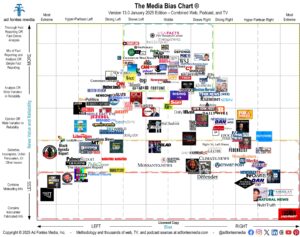Chapter 3 – Finding Your Voice & Making It Heard
3.7 Media Bias & Sensationalism
As you navigate through various news sources, it’s important to be aware of media bias and sensationalism and how they can influence the information you receive.
Media bias refers to the tendency of journalists and news producers to report events and stories in a way that reflects a particular perspective or agenda. This can result in presenting information that is partial, unbalanced, or slanted, potentially influencing public perception and opinion. Media bias can be influenced by various factors, including business models. For example, many cable news channels rely on advertising revenue to sustain their operations. This financial dependency can lead these outlets to frame their coverage in certain ways to attract and retain viewers or readers. As a result, they may prioritize a specific ideology, target content for specific demographics, and reflect the interests of their owners, all of which contribute to biased portrayals of events.
This quest for viewers, subscribers, and clicks can also lead to sensationalist reporting.
Sensationalism involves prioritizing dramatic, shocking, or emotionally charged stories over more substantive and balanced reporting. Infotainment and talking head shows contribute significantly to sensationalism. These programs often feature heated debates between opposing viewpoints rather than providing in-depth, investigative journalism. The goal is to keep viewers watching and increase ratings. However, this format can oversimplify complex issues, create false equivalencies, and prioritize sensationalism over factual reporting.
Sensationalism leads to a distorted view of events and issues by focusing on the most attention-grabbing aspects rather than providing a comprehensive understanding. Be aware of what you’re reading and watching and take it with a grain of salt. Always approach online content critically, check the sources, and be mindful of the impact of the content you engage with. This way, you can make more informed decisions and avoid contributing to the spread of misinformation.
Media Bias/Fact Check (MBFC) is a valuable resource that helps you understand the biases of different news outlets and the reliability of their reporting. MBFC rates news sources based on their bias (left, right, center) and their adherence to factual reporting. These ratings can help you critically assess the information you consume and ensure that you are getting a balanced perspective.
Let’s explore the Media Bias/Fact Check website. Look up the news sources you frequently use and review their ratings. Pay attention to the bias category they fall into and the level of factual reporting they adhere to.
- Go to the Media Bias/Fact Check website: https://mediabiasfactcheck.com/.
- Use the search bar to look up at least three news sources you regularly read or watch.
- Note the bias rating (left, right, center) and the factual reporting rating (high, mixed, low) for each source.
- Reflect on how these ratings might influence your perception of the news and consider diversifying your news consumption based on these insights.
Another tool comes from Ad Fontes Media, a company that evaluates information sources to help advertisers better understand their audiences and consumers assess media reliability and bias. You may have seen their Media Bias Chart shared on social media. Ad Fontes Media ranks news outlets based on political bias and reliability, which provides a resource for understanding how different sources present information. Explore their interactive chart here or check out their static chart below:

By exploring these sites, you’ll gain a better understanding of the potential biases in your news sources and learn how to approach information with a more critical perspective. This practice will help you become a more discerning consumer of news and improve your overall media literacy.
It’s important to note that media bias encompasses more than just political left, right, and center perspectives; it also includes biases related to cultural, social, and economic issues. For example, a news outlet based in a major city might emphasize the benefits of public transit expansion, walkability, and reducing traffic congestion, whereas a rural-focused publication may focus on road maintenance, broadband access, and concerns about urban policies being applied to rural communities. Both perspectives are shaped by location and lived experience rather than a strict left/right divide.
Reporting on nutrition and health trends can vary based on industry perspectives. A wellness-focused publication may promote plant-based diets and organic foods as essential for health, while a food industry-backed source may highlight the affordability and accessibility of processed foods. These biases are shaped by commercial interests rather than just political alignment.
Remember that news outlets, especially for-profit ones, rely on attracting and retaining audiences to generate revenue. This means their editorial decisions are often shaped by the need to appeal to specific viewer or reader preferences. Whether through subscriptions, ad revenue, or sponsored content, media organizations benefit from crafting stories that engage their target audience. While not all bias is intentional or profit-driven, the economic realities of the news industry mean that editorial decisions are frequently influenced by what attracts and maintains an audience. This creates an incentive to frame stories in ways that resonate with specific groups. This practice reinforces certain narratives over others. Again, it’s best practice to diversify your news sources.

